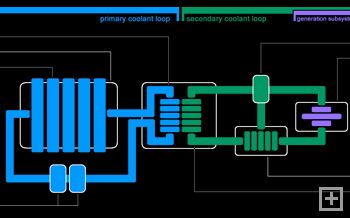
The ISDC’s Generation Program has released an overview of the fusion reactor’s coolant system, coinciding with the commencement of system prototyping. This prototyping is an important next step in the development of a working power system for vessel construction
The coolant system will use thermal energy from the reactor to generate the steam used to drive a power-generating turbine.
“With reactor prototyping well advanced, development of a coolant system is the next logical step in generation system development,” says Generation Program chief LCDR Robert Hewson.
Despite the system’s name, cooling is only a secondary function. By drawing away thermal energy from the reaction chamber, the coolant system does provide a degree of protection to reactor components, but the primary role of the system is harnessing the thermal output of the reactor for generation purposes.
“Failure of the coolant system wouldn’t be good for the long-term health of the reactor, but it wouldn’t be as catastrophic as an equivalent failure in a fission reactor,” says Hewson. “The coolant system is far more about thermal transfer rather than system protection.”
 The coolant system consists of two closed loops. The ‘reactor side” primary coolant loop surrounds the reaction chamber, absorbing heat and transferring it to the ‘generation side’ secondary coolant loop via a heat exchange system. This separation prevents radiation transfer outside of the reactor environment.
The coolant system consists of two closed loops. The ‘reactor side” primary coolant loop surrounds the reaction chamber, absorbing heat and transferring it to the ‘generation side’ secondary coolant loop via a heat exchange system. This separation prevents radiation transfer outside of the reactor environment.
“This architecture is very similar to what you’d see on a nuclear submarine,” says Hewson. “It has proven itself robust and efficient over decades so we only expect to have significant redesign effort around subsystems affected by the environmental differences posed by operation in space.”
One such subsystem involves the cooling of steam once it has passed through the turbine, so that it can be recycled through the loop. This will be achieved using Radiant Heat Sink Arrays (RHSA’s) which will provide cooling by radiating heat into space as efficiently as possible.
“The actual transfer of heat into space is pretty straight-forward,” says Hewson. “But unlike underwater, the associated IR [Infra-Red] radiation risks increasing the vessel’s detection profile in tactical situations. So it’s something we’ve been thinking very hard about.”
More detailed technical documentation will be released as the prototyping phase gives way to final system design and construction.
The coolant system overview can be found here.
- Log in or register to post comments







